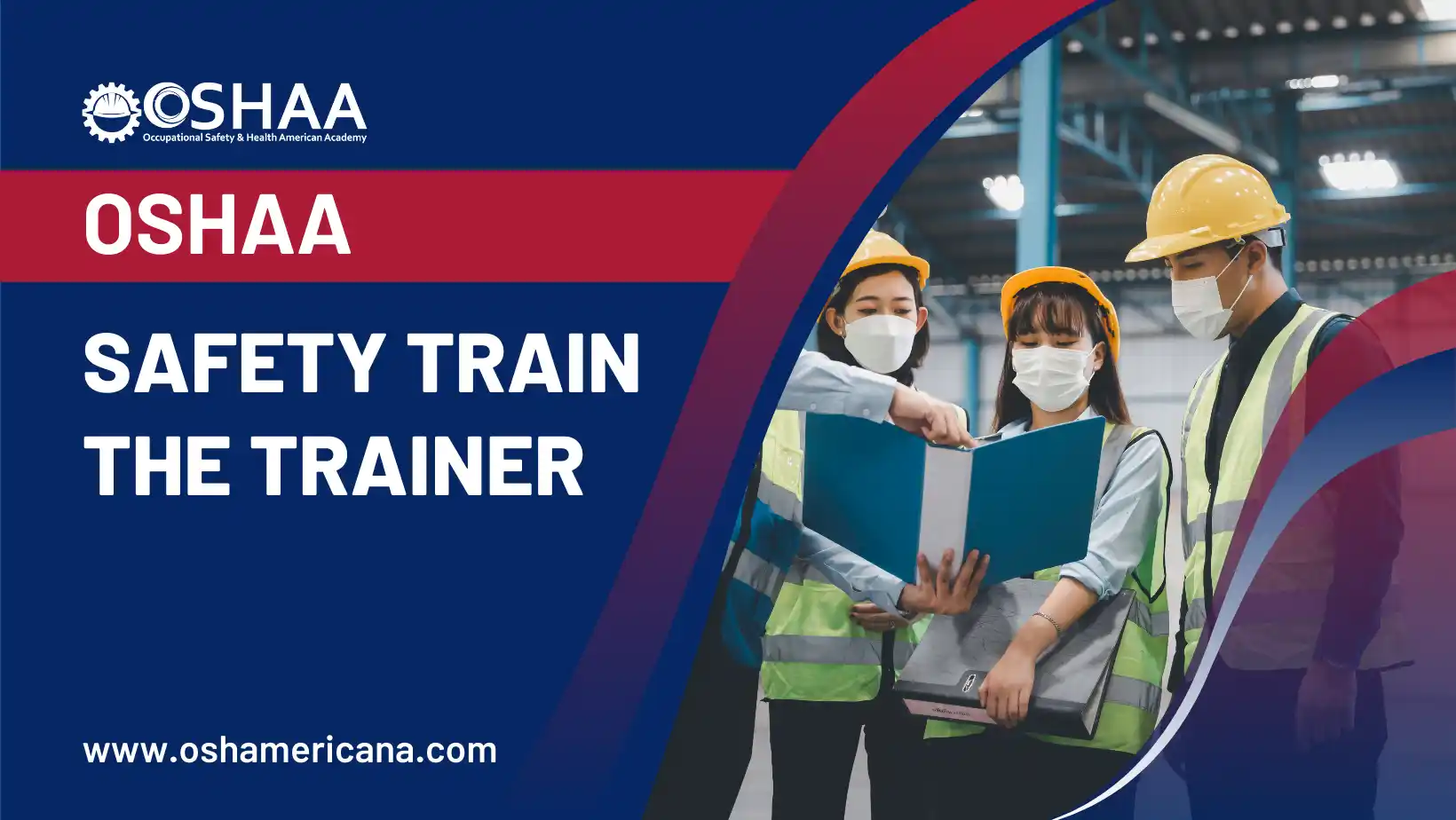Advance your career with the OSHAA Safety Train the Trainer course. Gain the expertise to deliver effective safety training, ensure compliance, and build a stronger workplace safety culture.
The OSHAA Safety Train the Trainer course is a comprehensive professional development program designed to equip individuals with the knowledge, skills, and confidence to lead safety training initiatives within their organizations. In an era where workplace safety and regulatory compliance are central to operational success, this course provides participants with the tools needed to become effective trainers who can influence culture, reduce risks, and ensure adherence to safety standards across diverse industries.
The course goes beyond simply introducing workplace safety procedures. Participants gain an in-depth understanding of occupational safety and health regulations, advanced instructional methodologies, and practical strategies for designing and delivering impactful training sessions. By combining technical knowledge with effective communication and leadership skills, the OSHAA Safety Train the Trainer course empowers professionals to create engaging programs that not only meet compliance requirements but also inspire behavioral change and long-term safety improvements.
Developed by industry experts, the OSHAA Safety Train the Trainer course reflects the latest OSHA standards and international best practices, ensuring that graduates are fully prepared to address modern workplace challenges. The curriculum emphasizes real-world application, offering participants practical experience in training design, delivery, and evaluation. Safety managers, supervisors, HR professionals, and health and safety officers will find this course invaluable for enhancing their ability to foster compliance, strengthen organizational resilience, and promote a culture of safety at every level.
What sets the OSHAA Safety Train the Trainer course apart is its global recognition and credibility. Delivered under the trusted framework of the Occupational Safety and Health American Academy (OSHAA), the program is widely respected by organizations worldwide as a benchmark for safety excellence. Graduates of the course become influential leaders capable of reducing workplace incidents, protecting employees, and ensuring business continuity through effective hazard prevention and compliance strategies.
Ultimately, the OSHAA Safety Train the Trainer course is more than a certification—it is a transformative learning experience that positions participants as safety leaders. By completing this program, professionals not only advance their careers but also contribute to safer, healthier, and more productive workplaces. This investment in professional growth delivers long-term benefits for both individuals and organizations, making it an essential step for those committed to excellence in workplace safety and compliance.
OSHAA Safety Train the Trainer
To enroll in the OSHAA Safety Train the Trainer course, learners are expected to meet the following criteria:
Age Requirement
- Participants must be at least 18 years of age to register for the OSHAA Safety Train the Trainer course. This minimum age ensures that learners are prepared for the professional responsibilities associated with safety training and compliance.
Educational Background
- A minimum of a high school diploma or equivalent is recommended for enrollment in the OSHAA Safety Train the Trainer course.
- Higher education in occupational health, safety management, engineering, or a related field is considered an advantage, as it provides a stronger foundation for understanding advanced safety training methodologies.
Work Experience
- Prior work experience in occupational health and safety, training, supervision, or related industries is recommended for participants enrolling in the OSHAA Safety Train the Trainer course.
- While not mandatory, professional exposure to workplace safety practices enhances learners’ ability to apply the knowledge and skills gained during the program in real-world scenarios.
English Proficiency
- Learners must have the ability to read, write, and speak English fluently to succeed in the OSHAA Safety Train the Trainer course.
- English proficiency is necessary to comprehend course materials, regulatory requirements, safety standards, and to effectively deliver training sessions to diverse audiences.
The OSHAA Safety Train the Trainer course maintains these eligibility requirements to ensure participants are fully prepared to develop their skills as professional safety trainers. By meeting these criteria, learners position themselves to benefit from a globally recognized program that strengthens compliance knowledge, leadership ability, and workplace safety expertise.
Study Units
Learning Outcomes
The OSHAA Safety Train the Trainer course is designed to equip professionals with advanced knowledge, compliance expertise, and leadership skills required to promote workplace safety and train others effectively. By completing this course, learners gain a comprehensive understanding of OSHA standards, safety training methodologies, and practical strategies for developing and managing impactful safety programs. The learning outcomes reflect the essential skills and competencies that participants will achieve throughout the program.
- Unit 1: Introduction to OSHA and the Role of a Trainer
- Gain a clear understanding of the history, purpose, and mission of OSHA and OSHAA.
- Recognize the importance of workplace safety and health training as a foundation for organizational success.
- Identify the key roles and responsibilities of a safety trainer within diverse workplace settings.
- Evaluate the skills, qualities, and ethical considerations necessary for effective safety training delivery.
- Unit 2: Understanding OSHA Standards and Regulations
- Develop a thorough comprehension of OSHA standards, their structure, and their role in workplace safety.
- Identify and interpret critical OSHA regulations across different industries.
- Understand compliance requirements, enforcement mechanisms, and the implications for organizations.
- Apply resources and case studies to stay current with OSHA standards, identify common violations, and integrate best practices.
- Unit 3: Developing Effective Training Programs
- Conduct training needs assessments to align programs with organizational requirements.
- Define clear objectives and outcomes for effective safety training.
- Design comprehensive training programs using structured approaches that meet OSHA compliance needs.
- Create engaging training materials and integrate adult learning principles to enhance retention and participation.
- Unit 4: Training Techniques and Methodologies
- Distinguish between various training methods and apply them to different workplace environments.
- Implement effective delivery strategies to maintain engagement and maximize learning.
- Integrate technology and multimedia resources to strengthen training impact.
- Deliver practical demonstrations and adapt methods to diverse learning styles and trainee needs.
- Unit 5: Communication Skills for Trainers
- Apply strong verbal and non-verbal communication skills in safety training contexts.
- Use active listening, questioning, and feedback techniques to enhance trainee understanding.
- Overcome communication barriers and facilitate productive group interactions.
- Manage challenging participants and training situations with confidence and professionalism.
- Unit 6: Safety Program Management
- Identify the essential components of a successful safety program.
- Conduct thorough hazard identification and workplace risk assessments.
- Develop and implement safety policies, procedures, and emergency preparedness plans.
- Evaluate safety program effectiveness and drive continuous improvement.
- Unit 7: Evaluation and Assessment
- Design effective assessment tools including quizzes, simulations, and feedback systems.
- Implement diverse evaluation methods to measure training effectiveness.
- Analyze trainee performance and use results to refine training strategies.
- Provide constructive feedback and maintain proper certification and record-keeping.
- Unit 8: Special Topics in Safety Training
- Develop targeted training strategies to address industry-specific hazards and high-risk environments.
- Deliver specialized safety training tailored for sectors such as construction, manufacturing, and oil and gas.
- Incorporate mental health, well-being, and ergonomic considerations into workplace safety initiatives.
- Stay informed about emerging technologies, global trends, and innovations shaping the future of safety training.
By completing the OSHAA Safety Train the Trainer course, participants will be prepared to lead safety initiatives, ensure regulatory compliance, and cultivate a strong safety culture within their organizations. This course provides the essential expertise and professional credibility needed to influence organizational performance, reduce risks, and promote long-term workplace safety excellence.
The OSHAA Safety Train the Trainer course offers a comprehensive range of benefits designed to strengthen the knowledge, skills, and leadership abilities of professionals responsible for workplace safety. This advanced training program not only equips individuals to deliver effective safety training but also enhances organizational performance by fostering compliance, reducing risks, and promoting a culture of safety. Recognized globally, the course provides industry professionals, organizations, and stakeholders with the opportunity to meet regulatory requirements, improve workforce well-being, and advance professional development.
- Enhanced Knowledge of OSHA Standards
Gain a deep understanding of OSHA standards and regulations, enabling you to effectively communicate safety requirements and compliance strategies to employees. - Strong Foundation in Training Methodologies
Develop advanced training techniques that allow you to design and deliver engaging, effective, and impactful workplace safety sessions tailored to diverse learning needs. - Improved Compliance and Legal Protection
Equip your organization with the knowledge to comply with OSHA requirements, reducing the risk of penalties, litigation, and regulatory non-compliance. - Reduction of Workplace Incidents
Apply effective safety training to minimize workplace hazards, reducing accidents, injuries, and illnesses while creating safer environments for all employees. - Professional Career Advancement
Position yourself as a certified trainer with recognized credentials, opening opportunities for promotions, leadership roles, and global career mobility. - Leadership and Communication Skills
Enhance your ability to influence, guide, and communicate effectively with teams, building stronger safety leadership across all organizational levels. - Organizational Cost Savings
Lower workplace incident costs by reducing compensation claims, downtime, and disruptions through preventive training and improved safety systems. - Employee Engagement and Productivity
Empower employees with practical safety knowledge that boosts morale, increases confidence, and improves overall productivity and performance. - Emergency Preparedness and Risk Management
Gain expertise in developing emergency response strategies and risk management frameworks that ensure readiness in crisis situations. - Customization of Safety Programs
Learn to design training programs specific to your industry, ensuring safety strategies are relevant, practical, and aligned with organizational goals. - Continuous Improvement in Safety Practices
Foster a proactive approach by identifying gaps, refining training strategies, and embedding continuous improvement into safety culture. - Recognition as a Safety Expert
Establish yourself as a trusted authority within your organization and industry, ensuring your role as a key contributor to long-term safety initiatives. - Global Relevance and Applicability
Benefit from training that is recognized worldwide, making your expertise applicable across industries and geographic regions. - Enhanced Organizational Reputation
Promote a strong safety culture that builds trust among stakeholders, clients, and employees, strengthening your organization’s reputation. - Future-Proofing Skills
Stay updated with evolving safety standards, modern training technologies, and emerging industry trends to remain a valuable resource in the long term.
The OSHAA Safety Train the Trainer course empowers participants with the skills and recognition to make a lasting impact on workplace safety. By combining professional growth with organizational excellence, it ensures that both individuals and businesses are fully prepared to meet safety challenges, achieve compliance, and foster sustainable improvement in health and safety standards worldwide.
The OSHAA Safety Train the Trainer course is designed for professionals and organizations committed to strengthening workplace safety, ensuring OSHA compliance, and fostering a culture of health and well-being. This program is highly relevant to industry professionals across multiple sectors, stakeholders responsible for workforce safety, and organizations aiming to align with international safety standards. Globally recognized, it provides participants with the expertise needed to deliver effective training, improve compliance, and advance professional development opportunities within their respective industries.
- Safety Professionals
- Safety specialists already working in occupational safety roles who want to elevate their skills in training and OSHA standards.
- The course helps them expand their expertise to deliver impactful safety programs across different workplace settings.
- By completing the program, they gain stronger credentials and the ability to lead compliance initiatives.
- This enhances both individual career growth and organizational safety performance.
- Supervisors and Managers
- Supervisors and managers overseeing daily operations with responsibility for safety and training.
- The course equips them with tools to design, implement, and monitor effective training initiatives.
- They gain the ability to influence safety culture at an organizational level.
- Completing the program ensures they meet OSHA compliance requirements while improving operational efficiency.
- Human Resources (HR) Personnel
- HR professionals tasked with employee development and compliance monitoring.
- The course enables them to integrate safety training into broader workforce development strategies.
- They gain practical skills in managing compliance documentation and reporting.
- This helps organizations maintain OSHA compliance while fostering safer workplaces.
- Training Coordinators
- Professionals responsible for organizing and conducting training sessions within companies.
- The program provides them with advanced knowledge of training methodologies and adult learning principles.
- They gain the ability to deliver engaging, effective, and compliant training content.
- This directly supports operational safety and organizational compliance efforts.
- EHS (Environmental, Health, and Safety) Officers
- EHS officers ensuring health and safety standards across industries.
- The course equips them with advanced training skills to better promote safety culture.
- They learn to design industry-specific safety programs that mitigate risks.
- This helps organizations reduce incidents while ensuring compliance with OSHA standards.
- Consultants
- Independent safety consultants offering advisory and training services.
- The program enhances their credibility and expertise in delivering OSHA-compliant safety training.
- They gain practical strategies to tailor training for diverse industries.
- This increases their professional marketability and client value.
- New Safety Trainers
- Individuals entering safety training roles who require structured and comprehensive preparation.
- The course builds foundational knowledge in OSHA standards and effective training delivery.
- They gain confidence in conducting impactful safety training programs.
- This prepares them for long-term careers in occupational safety and compliance.
- Industry Professionals
- Workers in high-risk industries such as construction, oil and gas, and manufacturing.
- The course provides them with specialized training skills to address industry-specific hazards.
- They gain the ability to identify risks and deliver solutions through training.
- This supports both individual safety and organizational compliance with OSHA regulations.
- Compliance Officers
- Professionals tasked with monitoring regulatory compliance across organizations.
- The course enhances their ability to interpret and implement OSHA standards.
- They gain training expertise to ensure workforce adherence to compliance requirements.
- This reduces legal risks and strengthens organizational accountability.
- Educational Institutions
- Instructors and educators delivering safety-related programs in schools, colleges, and universities.
- The course equips them with updated OSHA standards and effective teaching techniques.
- They gain the ability to prepare students for professional safety careers.
- This ensures future professionals are trained to meet global safety standards.
- Union Representatives
- Representatives advocating for safe working conditions and employee rights.
- The course provides them with advanced tools to deliver effective safety training.
- They gain expertise in addressing worker concerns and ensuring compliance.
- This strengthens their ability to protect member well-being and workplace safety.
- Non-Profit Organizations
- Staff of non-profit organizations focused on workplace safety advocacy.
- The course equips them with the knowledge to conduct community-based safety training.
- They gain credibility in promoting OSHA-compliant safety practices.
- This enhances their role in improving safety standards across industries.
- Emergency Responders
- Firefighters, paramedics, and other first responders involved in safety education.
- The course builds their ability to conduct structured safety and emergency training.
- They gain the expertise to prepare communities and organizations for emergencies.
- This supports both compliance and effective risk management.
- Government Agencies
- Employees of federal, state, or local agencies overseeing occupational safety.
- The program enhances their understanding of OSHA standards and training delivery.
- They gain skills to conduct inspections and guide compliance initiatives.
- This ensures public and private organizations meet safety expectations.
- Small Business Owners
- Entrepreneurs responsible for employee safety in small enterprises.
- The course equips them with practical tools to implement OSHA-compliant training programs.
- They gain cost-effective strategies to improve workplace safety and reduce risks.
- This builds safer, more resilient businesses aligned with regulatory standards.
The OSHAA Safety Train the Trainer course equips participants from diverse professional backgrounds with advanced knowledge, training skills, and compliance expertise. By completing this program, learners strengthen their ability to deliver effective safety education, ensure OSHA compliance, and foster operational excellence, making a significant impact on workplace safety across industries worldwide.







